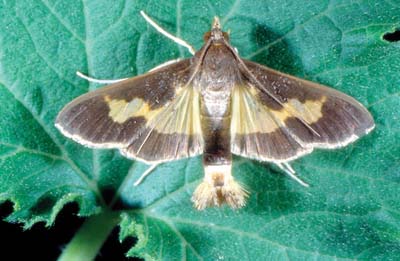
Pickleworm, Diaphania nitidalis, adult.
(Photographer: J. Capinera, University of Florida)
The pickleworm feeds only on cucurbits, including both wild and cultivated species. Winter and summer squash are considered to be good hosts. The larvae cause the damage and usually prefer blossoms. However, the larva commonly burrows into the fruit, and its entrance is marked by a small hole. Some hosts, such as cantaloupe, are not commonly burrowed into; instead, the rind is fed upon, causing scars. The pickleworm is sometimes referred to as a "rindworm." Sampling for the pickleworm is very difficult, and most growers depend on preventative applications of insecticides. Pollinators are commonly required in the production of cucurbits and should be taken into account before insecticides are applied. Cultural control practices include row covers and trap crops.
Images
To save the Web-optimized images shown below to your hard drive:
|
Click to access Display and Print quality images. |
|
Click to access Display and Print quality images. |
|
Click to access Display and Print quality images. |
|
Click to access Display and Print quality images. |
|
Click to access Display and Print quality images. |
|
Click to access Display and Print quality images. |